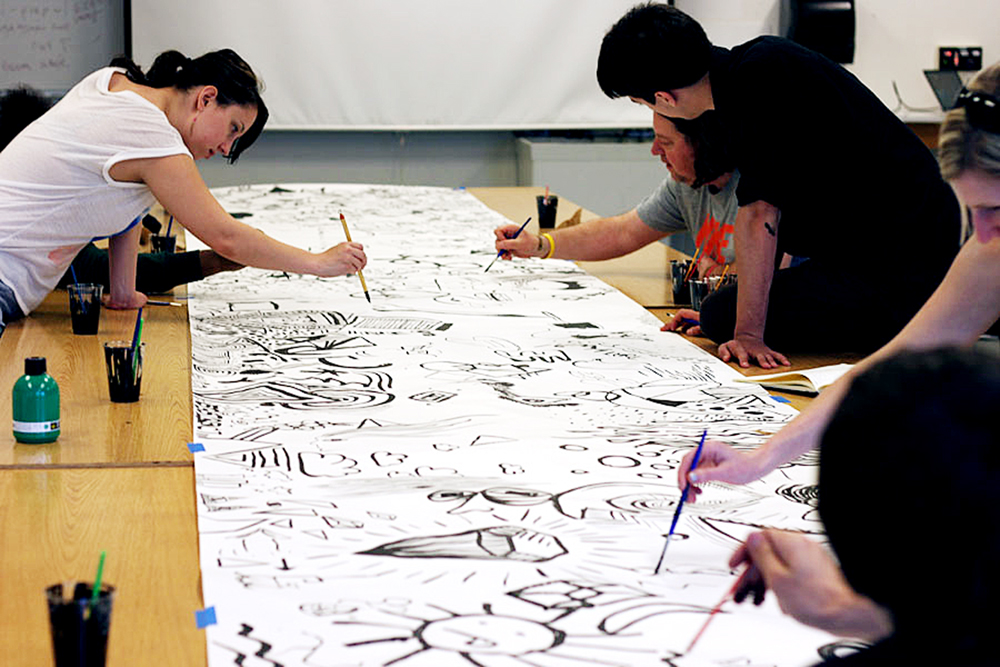“Sir, we’re closing for the night. I’m turning out the lights now.”
An old mustachioed security guard’s stern voice broke my concentration, if only for a second, on the headless mannequin’s paper dress in front of me. The disposable “Souper Dress,” covered with repeating likenesses of Campbell’s soup cans, had been designed by the company in response to Andy Warhol’s iconic “Campbell’s Soup Cans” (1962). In the late 1960s, the dress could have well been mine had I sent in the labels of any two Campbell’s vegetable soups, $1 USD and my dress size.
I could feel the cheap paper material crinkle against my skin almost as vividly as I could taste thick tomato soup on the back of my tongue. This decades-old advertisement, cashing in on the success of pop art, was working wonders on me.
“Feast and Famine: The Pleasures and Politics of Food,” the new exhibit on display at the Portland Art Museum, is full of thought-provoking works such as the aforementioned garb. Compiling art from around the world since 1850, the exhibit offers a look at how artists have used the seemingly prosaic subject of food to examine the self, reflect society and promote change. And it does so with a wide range of art: from Picasso to Pissarro, fine china to faux cookbooks.
“What first piqued my interest was, I noticed that we had some beautiful artist-designed menus in our collection…and I started thinking about artists and food,” said Mary Weaver Chapin, curator of graphic art at the museum.
“I started with this core idea of looking at the private rituals of dining and these beautiful menus that were done for just a select group, and then I started thinking in broader terms. I realized that artists have been engaging with the topic of food for hundreds of years in many different ways: from very playful themes, like in pop art…to really serious themes about hunger, food production and animal rights.”
I’d remembered Chapin’s words earlier as I’d crossed from the vestibule into the gallery, struck by the abrupt change between the vibrant commercial-European poster art of the first and the bleak portraits of field laborers and starving children in the second. One moment I was soaking up Henri Privat-Livemont’s “Absinthe Robette,” a Belgian advertisement for the anise-flavored drink; the next I was buried in Jean-Francois Millet’s evocations of back-breaking agrarian life in the French countryside and Kathe Kollwitz’s lithographs of the hardships of the poor in post-World War I Germany.
“There’s not one message, but a host of themes that I hope will get people thinking about how food is consumed and how artists have engaged with this topic,” Chapin said.
And though it may more than likely be the fault of space and layout restrictions, the juxtaposition of these different thematic sections in “Feast and Famine” come across as more than slightly comical.
I had been intently studying Picasso’s “Le Repas Frugal,” depicting an emaciated couple sitting down to a very meager meal, when I heard the shrill cackle of a woman coming from directly behind the pillar Picasso’s etching was mounted on.
“Haha, well would you look at that? Whole pigs, $4.90 a pound! Haha!”
The work the woman and her family were so entertained by was an untitled piece in the pop art section of the exhibit by Robert Gober: a mock grocery store coupon insert advertising, you guessed it, whole pigs for $4.90 a pound.
As I tried to puzzle out how the price of a pig could be so humorous, I began to imagine Picasso’s couple reaching out, with their long spindly arms wrapped around the pillar, attempting to grab that whole hog, to fill their empty plate and their empty stomachs. They could even share a bit with Kollwitz’s starving children right next door, if they could only get their hands on it. A whole cooked pig right behind a starving crowd, just out of reach. What a world.
And then the lights went out.
As I passed the mustachioed security guard—who didn’t seem to like how slowly I was leaving—I took one last look at the Campbell’s “Souper Dress” and the rest of the incredible “Feast and Famine” gallery. How strange that such a seemingly simple topic could be so well represented and thematically diverse, yet unified? I felt inspired. I felt awestruck. Most of all, I felt hungry.
When the lights came back on, I was in a grocery store with a basket full of Campbell’s soup, trying my damnedest to find some absinthe.






